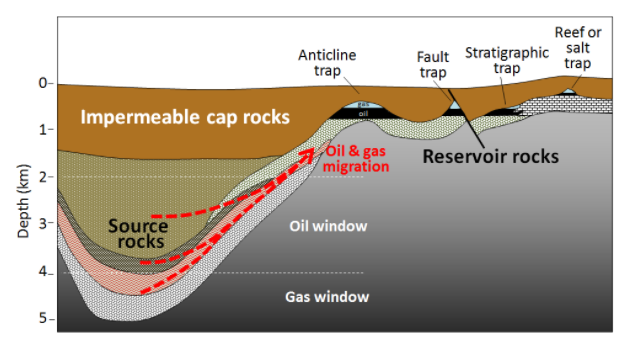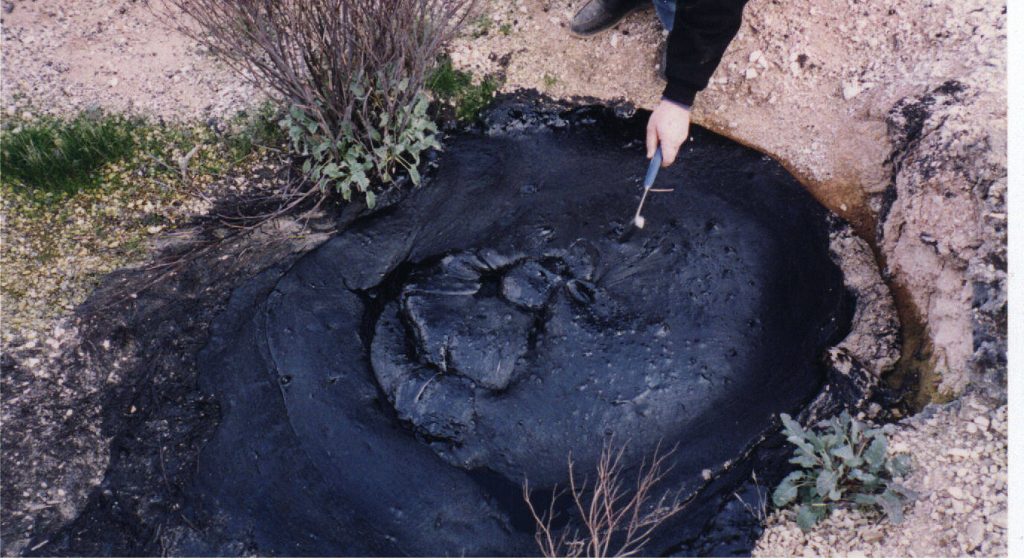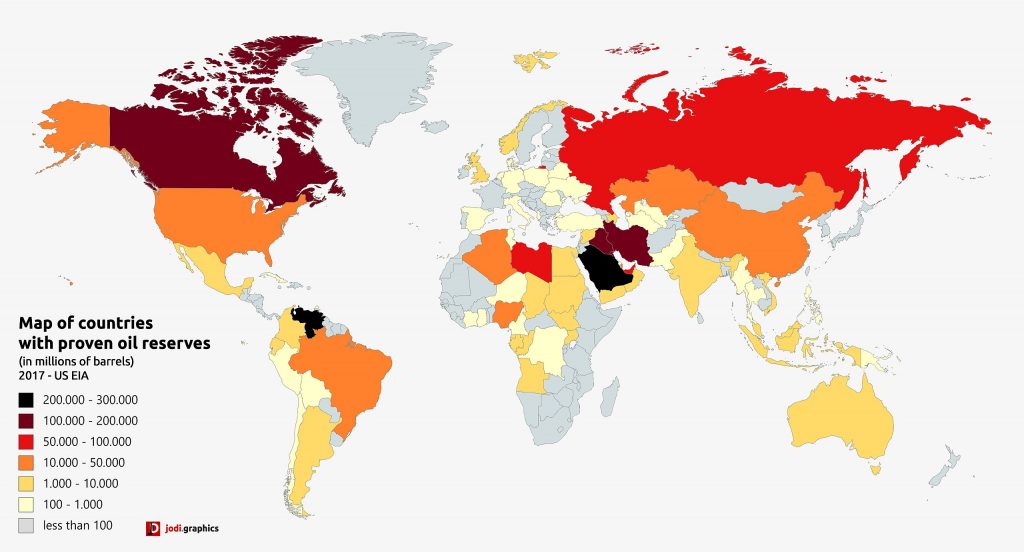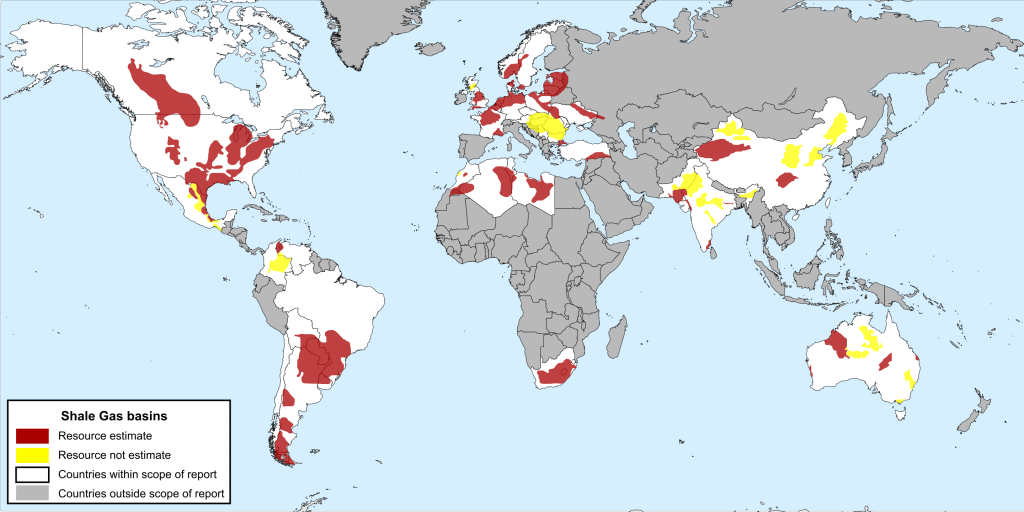10.3 Conventional Petroleum (Oil) and Natural Gas
Jeff Simpson and Carolina Londono Michel
Learning Objectives – By the end of this chapter, you should be able to do the following.
- Describe how petroleum and natural gas were formed.
- Draw and describe the geology of a natural gas and petroleum reservoir.
- Describe where petroleum and natural gas are found in the world, the US, and Arizona.
- List 5 ways we use natural gas and petroleum.
- Describe 4 environmental impacts of using natural gas and petroleum.
- Describe 4 political and social impacts of using natural gas and petroleum.
- Describe the production trends of oil and natural gas and explain why these trend are occurring.
Conventional Petroleum (Oil)
Organic-rich sediments buried in shallow marine environments close to continental edges formed petroleum and gas. As the organic-rich sediments are buried, the sediments become lithified or converted into rock such as (typically shale, mudstone, or limestone) while the organic matter transformed into kerogen. The kerogen then changes into oil. The shale, mudstone, or limestone in which hydrocarbons form are the source rock. Once created, the oil and gas migrate out of the source rock under pressure to a different rock usually located above the source (Fig 10.5). The rock that hosts the hydrocarbons is called the reservoir rock.

Reservoir rocks contain pores (are permeable), allowing fluids to enter and move. These pores also facilitate recovery of the oil or gas. Sometimes, the oil liquids and gasses make it all the way to the surface, where they form petroleum seeps. Ancient people used oil from seeps for sealing buildings and waterproofing boats.

The oil and gas oxidize at the surface and some of the carbon eventually returns to the atmosphere. In other cases, the fluids and gasses do not make it to the surface but aretrapped underground. An impermeable layer (e.g. mudstone or claystone) can seal the reservoir, impeding flow and storing the hydrocarbons underneath the Earth. The liquids and gasses that are trapped within reservoirs become layered based on their density, with gas rising to the top, oil below it, and water underneath. [3]
Video 10.3.1 – Oil 101(2:16)
A trap is a combination of a subsurface geologic structure and an impervious layer that helps block the movement of oil and gas and concentrates it for later human extraction. The development of a trap could be a result of many different geologic situations. Common examples include: an anticline or dome structure, an impermeable salt dome, or a fault-bounded stratigraphic block (porous rock next to non-porous rock). The different traps have one thing in common: they pool the fluid fossil fuels into a configuration in which extraction is more likely to be profitable. Oil or gas in strata outside of a trap makes extraction more difficult.
Where Petroleum Is Found
Petroleum distribution varies widely around the world. This leads to global competition and conflict. When those reserves are gone, they will not be renewed in our lifetime. Countries with proven oil reserves are shown below.

Conventional Natural Gas (Methane)
Natural gas (also called fossil gas or gas) is a naturally occurring mixture of gaseous hydrocarbons consisting primarily of methane and smaller amounts of other related organic compounds. Small amounts of carbon dioxide, nitrogen, hydrogen sulfide, and helium are also usually present. Natural gas is colorless and odorless, so odorizers such as mercaptan (which smells like sulfur or rotten eggs) are commonly added to natural gas supplies for safety so that leaks can be readily detected.
Natural gas is a fossil fuel and non-renewable resource formed when layers of mostly marine microorganisms decompose under anaerobic conditions and are subjected to intense heat and pressure underground over millions of years. The energy that the decayed organisms originally obtained from the sun via photosynthesis is stored as chemical energy within the molecules of methane and other hydrocarbons. Thus, the energy in natural gas really is stored solar energy.
Natural gas can be burned for heating, cooking, and electricity generation. It is also used as a chemical feedstock in the manufacture of plastics and other commercially important organic chemicals and less commonly used as a fuel for vehicles.
The extraction and consumption of natural gas is a major contributor to climate change. Both the methane and the carbon dioxide released when natural gas is burned, are greenhouse gases. However, when burned for heat or electricity, natural gas emits fewer toxic air pollutants, less carbon dioxide, and almost no particulate matter compared to other fossil and biomass fuels. However, gas venting and unintended fugitive emissions throughout the supply chain can result in natural gas having a similar carbon footprint to other fossil fuels overall. Additionally, unless controlled, the burning of natural gas can release N2O which is a potent greenhouse gas after carbon dioxide and methane.
Natural gas can be found in underground geological formations, often alongside other fossil fuels like coal and oil (petroleum). Most natural gas has been created through either biogenic or thermogenic processes. Biogenic gas is formed when methanogenic organisms in marshes, bogs, landfills, and shallow sediments anaerobically decompose but are not subjected to high temperatures and pressures. Thermogenic gas takes a much longer period of time to form and is created when organic matter is heated and compressed deep underground. (Link)
Figure 10.3.3 – Natural Gas 101 (3:38)
Figure 10.3.4 – LNG 101 (2:23)
Where Natural Gas Is Found

The solidification of loose sediment materials as solid sedimentary rock through compacting pressures and cementation.
A clastic sedimentary rock made of very fine-grained sediments such as muds, clays, and silts.
A rock composed of consolidated mud (clay, silt, or a combination of the two.)
An organic or chemical sedimentary rock that is primarily composed of calcium carbonate (CaCO3). Limestone is a subgroup of rocks that includes chalk, coquina, and fossiliferous limestone.
fossilized insoluble organic material that can be converted to petroleum.
Having permeability. The relative ease of fluid flow in a porous material

